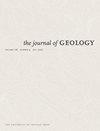大兴安岭南部早白垩世发掘:来自(U-Th)/He和裂变径迹热年代学的证据
IF 1.3
4区 地球科学
Q2 GEOLOGY
引用次数: 0
摘要
内蒙古东南部大兴安岭南部,华北克拉通以北,是一个受不同构造体制影响的地区。中新生代地质地貌演化至今仍有争议。本文利用锆石、磷灰石(U-Th)/He和磷灰石裂变径迹热年代学对花岗岩类进行了热演化分析,以约束不同构造活动叠加引起的出土史和地貌演化史。锆石(U-Th)/He定年得到早白垩世(109.1 ~ 134.9 Ma)和一个早二叠世(292.0 Ma)。磷灰石(U-Th)/He定年和裂变径迹定年分别得出早白垩世至晚白垩世早期89.8 ~ 117.6 Ma和97.8 ~ 99.9 Ma。结合已有的锆石U-Pb数据和热历史模拟,我们认为大兴安岭南部早白垩世经历了快速冷却和发掘。这一冷却阶段与中国东北地区广泛的伸展构造相一致,被认为是与蒙古-鄂霍次克洋相关的造山后地壳增厚塌陷和与古太平洋板块俯冲相关的弧后伸展引起的。研究结果表明,大兴安岭南部在新生代没有明显的出土记录。本文章由计算机程序翻译,如有差异,请以英文原文为准。
Early Cretaceous Exhumation of the Southern Great Xing’an Range, Northeastern China: Evidence from (U-Th)/He and Fission-Track Thermochronology
The southern Great Xing’an Range in southeastern Inner Mongolia, north of the North China Craton, is a region influenced by different tectonic regimes. The Mesozoic–Cenozoic geological and topographic evolution remains controversial. In this study, we decipher the thermal evolution of the southern Great Xing’an Range by applying zircon and apatite (U-Th)/He and apatite fission-track thermochronology to granitoids to constrain the history of exhumation induced by the superposition of different tectonic activities and the history of geomorphological evolution. Zircon (U-Th)/He dating yields Early Cretaceous ages (109.1–134.9 Ma) and one early Permian age (292.0 Ma). Apatite (U-Th)/He dating and fission-track dating yield Early Cretaceous to early Late Cretaceous ages of 89.8–117.6 and 97.8–99.9 Ma, respectively. Combining these ages with previously published zircon U-Pb data and thermal history modeling, we suggest that the southern Great Xing’an Range experienced rapid cooling and exhumation during the Early Cretaceous. This cooling stage coincided with widespread extensional tectonics in northeastern China, which are thought to have been induced by the postorogenic collapse of thickened crust associated with the Mongol-Okhotsk Ocean and backarc extension associated with subduction of the Paleo-Pacific plate. This study implies that the southern Great Xing’an Range does not record significant exhumation during the Cenozoic.
求助全文
通过发布文献求助,成功后即可免费获取论文全文。
去求助
来源期刊

Journal of Geology
地学-地质学
CiteScore
3.50
自引率
5.60%
发文量
0
审稿时长
3 months
期刊介绍:
One of the oldest journals in geology, The Journal of Geology has since 1893 promoted the systematic philosophical and fundamental study of geology.
The Journal publishes original research across a broad range of subfields in geology, including geophysics, geochemistry, sedimentology, geomorphology, petrology, plate tectonics, volcanology, structural geology, mineralogy, and planetary sciences. Many of its articles have wide appeal for geologists, present research of topical relevance, and offer new geological insights through the application of innovative approaches and methods.
 求助内容:
求助内容: 应助结果提醒方式:
应助结果提醒方式:


